Soused Snapper Recipe
|
|
SpotX Wild Foods Recipe from Kevin Leech Ingrediants:
Directions:
|
Snapper From a culinary perspective, snapper is probably one of the most versatile species we have in our waters. 
It is relatively easy to catch, readily available throughout the North Island and the top half of the South Island, and can be prepared in many ways. It’s as delicious as raw fish as it is smoked and good for almost everything in between.
Snapper has played an important part in our history. Known as ‘tamure’ to the Maori and ‘bream’ to the early European explorers and settlers, the humble snapper was a regular part of their diet, either eaten fresh, or else salted, dried or smoked.
Lemon Crumbed Blue Moki Recipe
|
|
SpotX Wild Foods Recipe from Grant Dixon Ingrediants:
|
Blue Moki
 If you are a member of the Wellington land-based fishing fraternity, blue moki is probably the species held in highest esteem. Blue moki fishing spots are highly regarded and Wellington Surfcasting and Angling Club members guard theirs as though their lives depended on it.
If you are a member of the Wellington land-based fishing fraternity, blue moki is probably the species held in highest esteem. Blue moki fishing spots are highly regarded and Wellington Surfcasting and Angling Club members guard theirs as though their lives depended on it.
Moki belongs to the Latrididae family and are cousins to the trumpeter. Many of the characteristics are the same. The body is deep and compressed, the flesh firm and the mouth firm with thick lips and small teeth, not unlike a porae.
Notoriously good fighters, moki feed in a number of habitats and they like shellfish, crustaceans and small baitfish; they have even been known to browse on some seaweeds. Most WSAC members claim crayfish is the number-one bait for blue moki, which live to around 30 years and can grow to some 90cm in length. Mussel and tuatuas are other good baits.
Moki tend to feed at night around the shoreline, especially where there are lumps of foul ground to give them cover among sandy territory. Maori prize them highly as eating fish and have a special season for them in autumn, when they are caught in good numbers in deeper water off the eastern Bay of Plenty coast.
From a culinary perspective, the flesh holds together well, making it a popular table fish. It is best eaten as fillets, which are removed in the same way you would deal with a snapper or similar shaped fish. Moki can be poached, smoked, steamed, baked and fried.
Cod and Oysters Recipe
|
|
SpotX Wild Foods Recipe from Elly Smith Ingrediants:
Directions:
|
Blue Cod
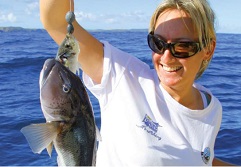 Blue cod is to Mainlanders what snapper is to their North Island counterparts.
Blue cod is to Mainlanders what snapper is to their North Island counterparts.
It is probably the number-one species on their hit lists and this unfortunately has created sustainability issues in the top half of the South Island. Here there are much debated ‘no-take’ and ‘limited-take’ zones in place, along with strict size limits.
Commercially, cod are targeted in ‘pots’ while recreationally, line fishing is the predominant method. If there is a ‘dumb’ fish, it is cod. They have none of the guile or reticence of snapper and will eat just about anything, even bare hooks or ones ‘baited’ with a little bit of shiny cigarette paper. Cod can even be caught on hooks baited with cod.
Curried Cod Recipe
|
|
SpotX Wild Foods Recipe from Kathy Dunstan
|
Classic Crayfish Mornay Recipe
|
|
SpotX Wild Foods Recipe from Grant Dixon
|
Crayfish
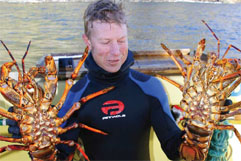
If there is a species that has been put on a pedestal as the pinnacle of Kiwi kaimoana, it is the spiny red rock lobster – crayfish. Over the years it has earned millions in overseas exchange and has made many of the commercial fishers, lucky enough to hold quota, rich men. Its dollar value sees the species, along with paua, at the head of the poachers’ hit list. In some regions it is estimated the ‘black market’ take is almost as high as the legitimate commercial harvest, both far surpassing the recreational catch. Despite the pressure on the fishery, crayfish still remains available to Joe Public provided they are prepared to put in the effort diving or potting for them. To many people a highlight of their holiday programme is to catch a few ‘bugs’ for the table.
The beauty of crayfish is that it can be prepared in so many different ways; its rich flesh requires little enhancement.
Like all seafood, crayfish benefit from taking a little care from the time they are caught to when they are served up. Once caught, the crayfish should be placed in a cool, damp spot. They will live for several days out of the water if kept cold and wet.
Most people prefer to deal with the catch as soon as practical. The first step is to kill the crayfish humanely by drowning it in a bin of cold fresh water. Placing a live crayfish directly into boiling water will result in the legs falling off more easily.
If you intend ‘cooking’ the crayfish immediately by boiling it, there are some simple steps to take to bring the best out of your catch. It is important to bring the water to a rolling boil before placing the crayfish in it. Do not overload the pot as it takes too long to bring it back on the boil; keeping the lid on the pot helps with this. Time the crayfish once the water starts to boil. The ‘just legal’ crayfish should be boiled for no longer than six minutes, and up to 12 minutes for ‘monster’ four-kilo-plus crayfish.
Once time is up take the crayfish out of the pot and place in a tub of cold water to halt the cooking process, then remove and leave to drain. A good way to do this is to hook the curled-up tails on the rim of a bucket.
Once cooled and the flesh set, the tail can be twisted free of the body and sliced lengthwise with a sharp, sturdy knife to split it. The alimentary canal will be exposed and this should be removed. Similarly the body can be sliced lengthwise in two, exposing the ‘engine room’. The yellow ‘mustard’ can be removed and used to give flavour to any sauce.
To many people, sucking the sweet morsels out of the legs and body is every bit as good as the tail meat. Use a nutcracker or a purposebuilt lobster claw cracking tool to crack the shell.
Moroccan Elephant Fish Recipe
|
|
SpotX Wild Foods Recipe from Petra Moorby
|
Elephant Fish
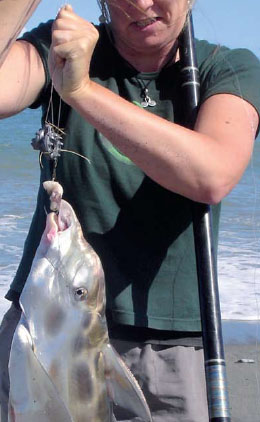 While it might not win any beauty pageants, the elephant fish is recognised in southern parts of New Zealand as a good eating specimen.
While it might not win any beauty pageants, the elephant fish is recognised in southern parts of New Zealand as a good eating specimen.
It features a large, fleshy, cartilaginous trunk that protrudes from the snout – and together with large winglike pectoral fins – combines to give the fish a rather grotesque deformed appearance rather like Quasimodo. The snout has a useful purpose, being used to root out crabs and shellfish from muddy or sandy bottoms. When handling the fish you need to be aware of the large, sharp folding spine that forms part of the dorsal fin.
Elephant fish are closely related to sharks, having a backbone of gristle rather than a skeleton. It is not surprising that the flesh tastes a bit like lemon fish (rig or dogfish) and is popular for fish and chips, as the firm flesh holds together well and you get two boneless fillets when you prepare it for the table. It is sold in the fish shops as silverfish and silver trumpeter.
Elephant fish is caught commercially by trawlers, but between October and late summer it comes within reach of surfcasters and boaties fishing inshore, sheltered waters such as Wellington Harbour.
Citrus Flounder Recipe
|
|
SpotX Wild Foods Recipe from Gillian Maire Ingrediants:
Directions:
|
Flounder
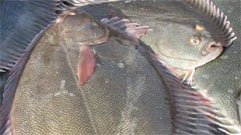 The name ‘flatfish’ covers a number of species in general terms, including yellow-bellied flounder, dabs and soles. Call them what you like; they are all good eating fish, with the yellow-bellied flounder being the culinary pick of the bunch.
The name ‘flatfish’ covers a number of species in general terms, including yellow-bellied flounder, dabs and soles. Call them what you like; they are all good eating fish, with the yellow-bellied flounder being the culinary pick of the bunch.
These species can be found all over New Zealand in a variety of environments on the open mud and sandy bottoms; way out wide to the surf line inshore, as well as the sandbanks and mudflats of our harbours. They are trawled, netted and speared, the last done mostly on still nights in the shallows.
Divers gathering scallops and oysters regularly come across flounder and soles hunkering down on the ocean floor where they attempt to hide by covering themselves in silt and sand. It is only their oval outline that gives them away and when disturbed they have an amazing turn of speed over a short distance.
Fly casting and light-tackle anglers with a great deal of patience have turned catching flounder into something of an art form, using small crab-imitation flies or vegetables such as peas and corn to catch dinner. They report the flounder give a good account of themselves on the light gear.
As table fare, flounder are high up there in the top 10 of the most popular eating fish. They have a delicate flavour, not unlike john dory, and can be prepared simply by taking out the gut and cooking whole. Freshly caught flounder fried in clarified butter or a lemon-infused olive oil, with a little salt and pepper, takes a great deal of beating. Cooked flounder roe, which is not removed in the gutting process, is something of a delicacy.
There is a bit of a learning curve with successfully negotiating a flounder fillet. Cooked properly, the flesh can be easily picked off one side before flipping the whole fish over and demolishing the other side, steering clear of the small bones on the outer extremities of the backbone.
Larger flounder can be filleted using a sharp, flexible knife. Make the first cut from the back of the head on the diagonal past the gills and pectoral fin. Keeping the blade tight against the backbone, work down towards and over the spine, progressing back toward the tail, as you would for most other fish such as snapper. Leave the skin on as this crisps-up well and holds a great deal of flavour.
Gemfish in Chermoula Marinade Recipe
|
|
SpotX Wild Foods Recipe from Henry Scott
|
Gemfish
 When you are fishing in deep water for more desirable species such as hapuku and bass, those tentative bites you sometimes feel are quite often gemfish. Having hauled these fish out of the depths, you might be quite disappointed, but gemfish can make for a tasty meal if prepared properly.
When you are fishing in deep water for more desirable species such as hapuku and bass, those tentative bites you sometimes feel are quite often gemfish. Having hauled these fish out of the depths, you might be quite disappointed, but gemfish can make for a tasty meal if prepared properly.
Often wrongly identified as hake, gemfish are good eating if looked after and treated with the same respect you would hapuku and the like. They have an oily flesh that makes them particularly good as fodder for the smoker. Some say smoked gemfish is as good as it gets.
It is also a good species for cooking in a number of conventional ways and can be fried, steamed, baked and barbecued. Gemfish’s strong flavour and firm texture makes it ideal for Asian and Mediterranean-style dishes as it can withstand strong, bold flavours.
It is filleted the same way you would a kingfish or a trumpeter. The stomach cavity contains an off-putting yellow, bile-like liquid, which it pays to keep away from the flesh.
Quick Seafood Medley Recipe
SpotX Wild Foods Recipe from Janet Thorne
Prep:15 minutes Cook:10 minutes Difficulty:2
Ingrediants:
|
Gurnard
 ‘Carrots’, ‘grunters’, or just plain old gurnard, this species was one of the piscatorial under-achievers in the culinary world for many years.
‘Carrots’, ‘grunters’, or just plain old gurnard, this species was one of the piscatorial under-achievers in the culinary world for many years.
They are a magic fish, resplendent with their colourful ‘wings’, but their succulent fillets have not, until recent times, always been fully appreciated.
As the more popular species such as blue cod and snapper became more expensive and difficult to catch, gurnard came increasingly to the fore. The flesh is firm and flavoursome and has become popular, along with tarakihi, in the fish and chip shops around the nation, not to mention on our own tables.
Balinese Bass Recipe
SpotX Wild Foods Recipe from Simon Mullens
Prep:4 hours Cook:10 minutes Difficulty:1
Ingrediants:
|
Hapuku (groper) bass and Bluenose
_bass_and_Bluenose.jpg) These three popular recreational species are quite often incorrectly lumped together, under the heading ‘hapuku’.
These three popular recreational species are quite often incorrectly lumped together, under the heading ‘hapuku’.
When the angler in your household says he is heading out ‘’puka fishing’ he generally means he is targeting all three species. They all live, as a rule, in water 100 metres-plus deep with bass and bluenose in particular being cellar dwellers.
All three have similar eating qualities. Their flesh is firm and white, and as a group of species they are much sought after in the eating stakes.
John Dory in White Wine Sauce Recipe
SpotX Wild Foods Recipe from Ken Crossman
Prep:10 minutes Cook:15 minutes Difficulty:1
Ingrediants:
|
John Dory
 Ask most anglers to list their ‘top five’ table fish and it is a safe bet the majority will include john dory.
Ask most anglers to list their ‘top five’ table fish and it is a safe bet the majority will include john dory.
While it might not win too many beauty contests with its angular, extendable jaw, the john dory is popular with those who do the cooking and those doing the fish eating in any angling household.
It has a fine flesh that is both firm and flavoursome. Filleting and skinning it can be something of a mission, but the effort is well worthwhile. John dory is not a scavenger like snapper; it is a hunter. It relies on stealth and concealment, waiting for dinner to swim its way before extending its jaws and ‘sucking’ its prey in.
Infused Kahawai Parcels Recipe
SpotX Wild Foods Recipe from Jade Chalmers
Prep:10 minutes Cook:10 minutes Difficulty:1
Ingrediants:
|
Kahawai

Known in more recent times as ‘the people’s fish’, kahawai is a species that European New Zealanders, until recently, treated with some disdain.
“I don’t eat bait!” was for many years a common call as the kahawai was kept for just that – as a lure to catch more popular recreational species. But like gurnard and trevally, kahawai is seen more commonly on our tables and is less often destined for the bait freezer.
Marinated Kingfish Steaks Recipe
SpotX Wild Foods Recipe from Grant Dixon
Prep:20 minutes Cook:10 minutes Difficulty:2
Ingrediants:
|
Kingfish
 In more recent times kingfish has almost become a ‘recreationalonly species’. The Total Allowable Commercial Catch is spread widely, making it more of a by-catch than a species the fishing industry targets specifically.
In more recent times kingfish has almost become a ‘recreationalonly species’. The Total Allowable Commercial Catch is spread widely, making it more of a by-catch than a species the fishing industry targets specifically.
Recreationally, catching a big kingfish, 30kg or above, is the holy grail of sportfishing. The species is held in high regard by recreational anglers with many choosing to tag and return, or simply release, the bigger fish once they have been landed.
Kingfish is held in less regard for its eating qualities, but this is probably an unfair assessment. Prepared correctly, kingfish can be smoked, steamed, poached, baked, fried, barbecued or used as sashimi and sushi.
Nutty Trout Recipe
SpotX Wild Foods Guide: Recipe from Peter Richards
Prep:20 minutes Cook:20 minutes Difficulty:2
Ingrediants:
|
Directions:
|
Trout
 The various species of trout were introduced, but unlike rabbits, stoats, wallabies, possums, goats and the like, trout has not turned around and bitten us in the backside.
The various species of trout were introduced, but unlike rabbits, stoats, wallabies, possums, goats and the like, trout has not turned around and bitten us in the backside.
Our pristine waters have proven an ideal environment for several species of trout, which have acclimatised well.
And unlike England, trout and trout fishing is available to all Kiwis prepared to buy a license, rather than just a privileged few. Trout are available throughout New Zealand and countless visitors have been attracted to our shores in pursuit of them; following in the footsteps of noted writer and angler Zane Grey, who fished here and wrote about his experiences in the late 1920s.
Billy Ho’s Flamed Maomao Recipe
SpotX Wild Foods Recipe from Bill Hohepa
Prep:5 minutes Cook:15 minutes Difficulty:1
Ingrediants:
|
Mao Mao
 Bill Hohepa described maomao as the muttonbird (sooty shearwater) of the underwater world. Anyone who has tried to strayline down a berley trail over foul ground will appreciate Bill’s sentiments.
Bill Hohepa described maomao as the muttonbird (sooty shearwater) of the underwater world. Anyone who has tried to strayline down a berley trail over foul ground will appreciate Bill’s sentiments.
Marlin on a Muffin Recipe
SpotX Wild Foods Recipe from Grant Dixon
Prep:10 minutes Cook:10 minutes Difficulty:2
Ingrediants:
|
Marlin
 Smoking is the most practical way of sharing your prized striped marlin catch with friends and family.
Smoking is the most practical way of sharing your prized striped marlin catch with friends and family.
Its dark, oily flesh is perfect for brining and smoking and is considered the best eating of the three marlin species, followed by black marlin, with blue marlin a long way further back.
Baked Mullet Recipe
|
|
SpotX Wild Foods Recipe from Shannon Miles Ingrediants:
Directions:
|
Grey Mullet
 While many people think that grey mullet is best used as bait, for snapper in particular, it tantalises human taste buds as smoked fish.
While many people think that grey mullet is best used as bait, for snapper in particular, it tantalises human taste buds as smoked fish.
Mullet is popular smoked; the oily flesh that makes it ideal as a cut-bait also ensures it is a favourite among those who like their fish cured rather than cooked.
Split, gutted and gilled, mullet has a strong taste that is complimented by the smoking process. While smoked mullet roe is considered a delicacy, anglers value the gut, head and frames as bait or the basis of a good berley. Mullet is most common in the northern parts of New Zealand, where it is netted or beach-seined around our harbours and surf lines.
While most people consider it’s at its best as smoked fish, it can be prepared conventionally. The flesh is pinkish-grey and medium firm, with a high fat content.
Curried Octopus in Coconut Recipe
|
|
SpotX Wild Foods Recipe from John Eichelsheim Ingrediants:
Directions:
|
Octopus
 Octopus is not an uncommon catch for recreational anglers.
Octopus is not an uncommon catch for recreational anglers.
Octopus is seldom kept, however, and even less often cooked and eaten. But octopus is delicious eating – in many people’s opinion at least as good as squid. If you intend to keep an octopus for the table, kill it quickly and humanely. One method is to ‘turn it inside-out’, which involves doing exactly what the description says, but this does take a little practice as it can be tricky.
Polynesian people bite an octopus between the eyes, which kills it. You can achieve the same result by pushing a knife into the animal’s brain between the eyes. A dead octopus, like all seafood, should be iced down immediately. It keeps well frozen whole.
There are many good recipes for octopus, which is particularly popular as food in the Mediterranean and the Pacific. The recipes that follow reflect this.
Piper Stir-fry Recipe
SpotX Wild Foods Recipe from PJ Falls
Prep:10 minutes Cook:30 minutes Difficulty:1
Ingrediants:
|
Piper
 While most people regard fresh piper (garfish) as one of the ‘ultimate’ snapper and kingfish baits, those in the know also appreciate this ‘upside-down-marlin’ for its table qualities.
While most people regard fresh piper (garfish) as one of the ‘ultimate’ snapper and kingfish baits, those in the know also appreciate this ‘upside-down-marlin’ for its table qualities.
The easiest way to catch these little guys is to drag a bait-net in the surf line or along a beach or mudflat, but the job can be made much more challenging by using a rod and reel!
Fine line in the two-kilo range is perfect. Attach a float, a small length of trace and a size 20 or 22 sprat hook and you are ready to go. A great bait is a coarse dough made from flour and a little water and rolled with cotton wool to keep it together. Otherwise, slightly wet a small piece of bread, which can then be balled up around the hook. Other baits include processed cheese, pipi or squid, the secret being to keep it small – no larger than an average- sized pea.
Thai Porae Patties Recipe
SpotX Wild Foods Recipe from Simon Jowett
Prep:10 minutes Cook:25 minutes Difficulty:2
Ingrediants:
|
Directions:
|
Porae
 While porae are not the most sought-after fish, they have a white, moist flesh that has good Omega 3 levels and is suited to most cooking methods. They are closely related to tarakihi and moki.
While porae are not the most sought-after fish, they have a white, moist flesh that has good Omega 3 levels and is suited to most cooking methods. They are closely related to tarakihi and moki.
Porae like the warmer climes and are generally found from the Bay of Plenty northwards. They are more prolific on the east coast than the west. Porae feed along weed lines and over foul ground close to sandy bottoms, where they forage for food down to 60 metres or so.
Their main diet is crabs and other invertebrates. They are an inquisitive fish. A common practice among spear fishers is to grab a handful of sand off the bottom before heading for the surface for another breath. On diving back down again they will quite often encounter a porae fossicking in the scoop mark looking for its dinner.
For the sport fisher they are a worthy opponent: they grow to quite a good size and more than one angler, seeing them coming up on the end of their line, initially thinks he has caught a good snapper.
Porae are filleted in the same way you would a snapper, although the flesh is not quite as white or firm.
Mako in Herb Butter Recipe
SpotX Wild Foods Recipe from Ray Steele
Prep:15 minutes Cook:15 minutes Difficulty:1
Ingrediants:
|
Sharks
 Ever wondered where the name ‘shark and tatties’ originated? The answer is simple: for many years takeaway shops used ‘lemon fish’ or ‘doggie shark’, the common names for spotted dogfish or rig, as the species of choice for their fish and chips.
Ever wondered where the name ‘shark and tatties’ originated? The answer is simple: for many years takeaway shops used ‘lemon fish’ or ‘doggie shark’, the common names for spotted dogfish or rig, as the species of choice for their fish and chips.
Shark was easily caught and inexpensive, and incidentally made great fish and chips, battered and served with a squeeze of lemon.
Shikkered Salmon Recipe
SpotX Wild Foods Recipe from Brad Kyle
Prep:Overnight Cook:30 minutes Difficulty:2
Ingrediants:
|
Salmon
 Most of the cooking ‘rules’ that apply to trout can be adapted for salmon and vice-versa.
Most of the cooking ‘rules’ that apply to trout can be adapted for salmon and vice-versa.
While in recent years the runs of this fish up the rivers of the South Island have not been as prolific as in the past, salmon are still well worth targeting.
Regular fishers on the likes of Canterbury’s Waimakariri, Rakaia and Rangitata Rivers all have their favourite way of preparing salmon, including bottling, canning and smoking to ensure a store of this delicacy over the winter months, as well as recipes involving fresh fillets.
Many New Zealanders keenly anticipate the limited salmon season: if you have been fortunate enough to taste wild salmon, you will appreciate why.
For those who don’t count a salmon angler among their family or circle of friends, the good news is that it is farmed in New Zealand and can be purchased fresh over the counter at most supermarkets and seafood outlets.
Stingray Casserole Recipe
SpotX Wild Foods Recipe from Tricia Stubbings
Prep:15 minutes Cook:30 minutes Difficulty:2
Ingrediants:
|
Stingray
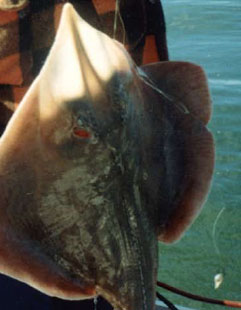 The stingray has earned its bad reputation from the sharp and often poisonous sting on its tail. But in thousands of underwater encounters, the animal has never threatened me. Here in New Zealand we know three species of stingray: the short-tailed ray, the long-tailed ray and the eagle ray. Stingrays have a unique body design, as they fly through the water rather like birds in the sky. Rays are cartilaginous fishes like sharks and do not have swim bladders to adjust their buoyancy. As a result their archenemy, the orca, doesn’t find it easy to locate them using sonar. Furthermore, rays are adept at burrowing into the sand, with only a casual flick of their wings.
The stingray has earned its bad reputation from the sharp and often poisonous sting on its tail. But in thousands of underwater encounters, the animal has never threatened me. Here in New Zealand we know three species of stingray: the short-tailed ray, the long-tailed ray and the eagle ray. Stingrays have a unique body design, as they fly through the water rather like birds in the sky. Rays are cartilaginous fishes like sharks and do not have swim bladders to adjust their buoyancy. As a result their archenemy, the orca, doesn’t find it easy to locate them using sonar. Furthermore, rays are adept at burrowing into the sand, with only a casual flick of their wings.
Even though they have bad eyesight, stingrays are reasonably intelligent and grow quite old. The short-tailed ray holds the size record, with individuals recorded weighing over 500kg and wingspans of 3.5m. I’ve seen only one such monster and I had to back off before I realised what it was.
Kiwifruit Squid Recipe
SpotX Wild Foods Recipe from Grant Dixon
Prep:12 hours Cook:10 minutes Difficulty:1
Ingrediants:
|
Squid
 As we become more familiar with Asian cuisine, the status of squid, or calamari, has grown from being good only as bait to a respected and enjoyed table fish.
As we become more familiar with Asian cuisine, the status of squid, or calamari, has grown from being good only as bait to a respected and enjoyed table fish.
When fishing it is not uncommon for anglers to experience a series of light taps on their lines; attacks on the bait that prove difficult to turn into hook ups. Many blame the attention of smaller fish for their bad fortune, but more often than not it will be squid attacking the offering. Change the conventional hooks or soft bait for a squid jig and see what happens!
Popeye’s Tarakihi Recipe
SpotX Wild Foods Recipe from Barry Robson
Prep:20 minutes Cook:20 minutes Difficulty:2
Ingrediants:
|
Tarakihi
 Tarakihi is a common species found right around New Zealand. They are a popular eating fish, being readily available to recreational and commercial fishers alike.
Tarakihi is a common species found right around New Zealand. They are a popular eating fish, being readily available to recreational and commercial fishers alike.
Tarakihi are silver-grey in colour, with a distinctive black band running down their bodies from behind the head. When the Three Kings Islands opened up to sportfishing, those looking for their dinner between targeting marlin ‘discovered’ an XOS tarakihi, named ‘king’ tarakihi, which has similar great eating qualities and grows to 5-6kg in size. King tarakihi are also caught in the Eastern Bay of Plenty and elsewhere.
Tarakihi are not unlike snapper in that at various times of the year they can be found schooling out over the deep mud or alternatively over deeper reef structure. Known for their longevity, many adults are 10-20 years old, with some even reaching 50 years of age.
When on the bite, tarakihi are voracious feeders. Some anglers affectionately refer to them as ‘Tic Tics’, on account of their repeated peck-like bite. They are commonly caught on ledger rigs tied using small 1/0 re-curved hooks or on commercially-tied rigs such as the Black Magic ‘Tarakihi Terrors’.
Tarakihi has a firm flesh and is easily filleted in the same way you would a snapper. The inside of the gut cavity has a black lining instead of the pearlescent one found in many other species, but don’t let that put you off as the meat is light in appearance and sweet. Tarakihi is a species that lends itself to a variety of approaches from the person in charge of the galley.
Mark’s Trevally Kokoda Recipe
|
|
SpotX Wild Foods Recipe from Mark Kitteridge Ingrediants:
Directions:
|
Trevally
 Like kahawai, trevally was for many years considered only good as bait. The flesh is relatively dark and quite oily, making it ideal for smoking. Filleted, the fish has a strong flavour that works well in pasta and other dishes where sauces might overpower the more delicate taste of other species. Trevally is also excellent grilled or barbecued as steaks, fillets or cooked whole. Where possible, leave the skin on – it helps keep the fish together and the fat under the skin keeps the flesh moist.
Like kahawai, trevally was for many years considered only good as bait. The flesh is relatively dark and quite oily, making it ideal for smoking. Filleted, the fish has a strong flavour that works well in pasta and other dishes where sauces might overpower the more delicate taste of other species. Trevally is also excellent grilled or barbecued as steaks, fillets or cooked whole. Where possible, leave the skin on – it helps keep the fish together and the fat under the skin keeps the flesh moist.
Trevally makes brilliant raw or marinated fish and is great in sushi or as sashimi. Trevally is best eaten fresh, as it does not freeze well.
Trevally can be caught seasonally around most of the New Zealand coast and quite often the schools of these fish can be seen gorging in krill on the surface. While this makes them relatively easy to find and catch for recreational fishers, unfortunately a commercial seine boat can hoover up whole schools in a single sweep.
Trevally are easy to fillet and are dealt with in the same way as you would a snapper. Removing the skin can be a little more difficult and requires a sharp knife run flat and firm between the skin and the flesh to remove in one piece. Because of its lack of ‘real’ scales, some people cook their trevally fillets with the skin on.
Trumpeter Poached in Coconut Milk Recipe
|
|
SpotX Wild Foods Recipe from Andre Filou Ingrediants:
Directions:
|
Trumpeter
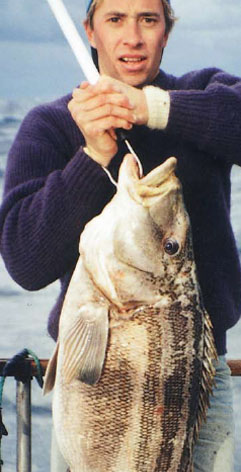 Trumpeter, a relative of the blue moki, is widely spread geographically.
Trumpeter, a relative of the blue moki, is widely spread geographically.
While they are rarely caught north of the Bay of Plenty, they become more prolific the further south you travel.
Some of the best grounds can be found off the South Island’s eastern seaboard, from the Kaikoura Coast right down around the corner to Fiordland and including Foveaux Strait and Stewart Island. The larger specimens like deep water, preferably around structure, and tend to move offshore in the winter months. They are renowned for their fighting ability and take jigs as readily as they do cut baits. The latter, combined with flasher rigs, is a consistent performer.
Unfortunately for trumpeter, they are generally found in good-sized schools, making them an easy target for commercial fishers. They can be quite territorial, which means they are quickly cleaned out of a popular fishing spot.
The good news is that trumpeter is a great eating fish and it hangs out with other top-ten culinary contenders – blue cod, tarakihi and groper. It has a firm flesh which makes it ideal for a number of dishes, especially fish casseroles, as it holds together well.
There are no secrets to filleting trumpeter. It is done in the same way you would fillet a snapper or ‘pup’ groper. It is a fish that ‘ages’ well, gaining in flavour intensity by being refrigerated for a couple of days in a well-drained container.
Zambucca Tuna Nibbles Recipe
SpotX Wild Foods Recipe from Steve Haddock
Prep:10 minutes Cook:3 minutes Difficulty:1
Ingrediants:
|
Tuna
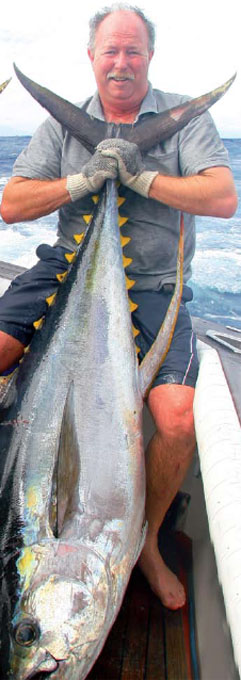 Many nations put a huge price on the meat of a number of tuna species, especially big-eye, yellowfin and bluefin tunas.
Many nations put a huge price on the meat of a number of tuna species, especially big-eye, yellowfin and bluefin tunas.
A single fish can fetch tens of thousands of dollars, particularly at Asian fish markets, if it’s handled correctly to ensure it arrives quickly and in prime condition.
The regard in which some tuna species are held has resulted in over-fishing throughout the Pacific, and in recent years yellowfin tuna especially have failed to reach New Zealand territorial waters in any numbers. A yellowfin or big-eye tuna is a prized catch, not only as a sportfish, but also for its eating qualities.
Blackened Warehou Recipe
|
|
SpotX Wild Foods Recipe from Pete Lamb ngrediants:
Directions:
|
Warehou
 Warehou, often nicknamed ‘Hou’ by Wellington anglers who seem to have a colloquial name for every species in their waters, are widely distributed around the coastline of the South Island as well as the southern North Island.
Warehou, often nicknamed ‘Hou’ by Wellington anglers who seem to have a colloquial name for every species in their waters, are widely distributed around the coastline of the South Island as well as the southern North Island.
They are a popular target species, for both recreational and commercial fishers, for their eating qualities. They have a firm flesh that is easy to fillet and skin.
Warehou inhabit the rocky shoreline and deepwater reefs down to around 120 metres. They tend to move in large shoals, making them quite vulnerable to commercial methods such as netting and trawling. Occasionally the fish will be found breaking the surface well out to sea and away from any obvious structure.
Recreational anglers catch them on bait or jigs. Black Magic Snapper Snatcher sabikis and the like also do the business.
Chive and Lemon Whitebait Fritters Recipe
SpotX Wild Foods Recipe from Cascade Whitebait
Prep:15 minutes Cook:10 minutes Difficulty:1
Ingrediants:
|
Whitebait
 One of New Zealand’s true delicacies, whitebait’s subtle taste is hard to put into words, but the price it demands in the shops, topping $100 a kilo at times, is testimony to its popularity among gourmets.
One of New Zealand’s true delicacies, whitebait’s subtle taste is hard to put into words, but the price it demands in the shops, topping $100 a kilo at times, is testimony to its popularity among gourmets.
There are some seven species of native fish whose larval phases are loosely called whitebait. During late winter and early spring, the dates determined by geographical location, whitebaiters head for the rivers, streams and coastal river mouths armed with a variety of nets to trap ‘bait.
Dogfish with Lemon and Garlic Recipe
SpotX Wild Foods Recipe from Becky Duncan
Prep:15 minutes Cook:10 minutes Difficulty:1
Ingrediants:
|
Jim’s Goose Roast Recipe
SpotX Wild Foods Recipe from Jim Hart
Prep:Overnight Cook:2 hours Difficulty:1
Ingrediants:
|
Canadian Geese
 Canada geese were introduced from North America in 1876 for recreational hunting, but did not get established until 1905 when 50 birds were brought into the country and liberated in a number of different regions. The birds flourished in the South Island but had died out in the North Island by the 1930s.
Canada geese were introduced from North America in 1876 for recreational hunting, but did not get established until 1905 when 50 birds were brought into the country and liberated in a number of different regions. The birds flourished in the South Island but had died out in the North Island by the 1930s.
In 1970 another attempt was made to establish the geese in the North Island and this was successful. Now they can be found in the Far North, Waikato, Taupo, Rotorua, Taranaki, northern Hawkes Bay, Manawatu and around Lake Wairarapa.
The geese mainly eat pasture and graze on crops, which has made them the enemy of farmers. It is said that one bird will eat and/or foul the equivalent pasture used to raise two sheep. If you wish to hunt Canada geese you will be welcomed with open arms onto most sheep stations around the country.
Thai Curry Duck Recipe
SpotX Wild Foods Recipe from David Robinson
Prep:2 hours Cook:½ hour Difficulty:3
Ingrediants:
|
Duck
 Hunting duck is one of those Kiwi activities steeped in tradition, especially in rural communities.
Hunting duck is one of those Kiwi activities steeped in tradition, especially in rural communities.
The first weekend in May is eagerly awaited and has greater status than some religious holidays. In anticipation of opening day considerable preparation will have gone into the maimai, the traditional duck hunter’s lair, and preparing ponds, which are sometimes pre-fed.
Prior to the big event, gun clubs hold shooters’ ‘eye-openers’. A number of clubs and pubs host hunters’ evenings to determine the most realistic duck caller, camouflage and the like. Shotguns are given that extra bit of attention and the faithful gundog gets caught up in all the hype too. The scene is being set for what is a special annual occasion for some 80,000 people around the country.
Like all sports, bird shooting has become more sophisticated as time goes by. The traditional side-by-side shotgun has largely given way to ‘under and overs’. Now semi-automatic guns with magazines capable of up to five rounds are the order of the day. Lead shot over our waterways has been banned to appease the green element – a vocal minority. Decoys are moulded from plastic and can be made to move on the water or to simulate flight, with wings that flap.
Even the species have changed. Areas that were once the domain of the grey duck have been taken over by the mallard, which in turn has been superseded in many regions by the larger, domineering paradise shelduck. But at the end of the day you still have to put shot in the air in the right place to intercept dinner – and that has not changed.
The rewards are worth it. Wild duck is excellent fare and can be prepared in a variety of ways. Traditionally the birds have been hung for a day or two then plucked and drawn, before being roasted or casseroled. More commonly today they are breasted out and presented in a variety of ways, including manufactured into salamis and sausages; recipes for some of which are outlined below.
Traditional Mutton Bird Recipe
SpotX Wild Foods Recipe from Pete Wiri
Prep:10 minutes Cook:3 hours Difficulty:1
Ingrediants:
|
Muttonbirds
 The muttonbird (shearwater chicks – usually but not exclusively sooty shearwaters) is a native of New Zealand: the Maori call it titi and it has been a prized delicacy for many generations.
The muttonbird (shearwater chicks – usually but not exclusively sooty shearwaters) is a native of New Zealand: the Maori call it titi and it has been a prized delicacy for many generations.
The small offshore islands around Rakiura (Stewart Island) and Bluff are known to be the home of the best muttonbirds. They can also be found on some offshore islands in the North Island, but not in any appreciable numbers. North Island Maori also harvested the young of other shearwater species, although the practice has become rare since seabirds are now protected.
English Pheasant Recipe
SpotX Wild Foods Recipe from Annette Henderson
Prep:2-3 hours Cook:30 minutes Difficulty:2
Ingrediants:
|
Pheasants
 Pheasants were introduced into New Zealand as a game bird for recreational hunters back in 1842; however, they did not really establish themselves until 1865 when successful breeding by the Canterbury Acclimatisation Society prompted the importation of more birds. Numbers increased and spread until the 1900s, when predators and competition for food from smaller imported birds was blamed for a drop in pheasant numbers. Breeding by the Acclimatisation Societies throughout New Zealand, combined with the breaking-in of farmland and careful husbandry by the now Fish & Game Councils, has since seen the birds flourish.
Pheasants were introduced into New Zealand as a game bird for recreational hunters back in 1842; however, they did not really establish themselves until 1865 when successful breeding by the Canterbury Acclimatisation Society prompted the importation of more birds. Numbers increased and spread until the 1900s, when predators and competition for food from smaller imported birds was blamed for a drop in pheasant numbers. Breeding by the Acclimatisation Societies throughout New Zealand, combined with the breaking-in of farmland and careful husbandry by the now Fish & Game Councils, has since seen the birds flourish.
Pukeko Patties Recipe
SpotX Wild Foods Recipe from Mark Airey
Prep:12 hours Cook:20 minutes Difficulty:1
Ingrediants:
|
Pukeko
 Pukeko is the Maori name for this colourful and cheeky bird. It means ‘swamp hen’, as the same bird is known in Australia. It is believed to have settled here 1,000 years ago, although there is only fossil proof of its existence here going back 400 years or so.
Pukeko is the Maori name for this colourful and cheeky bird. It means ‘swamp hen’, as the same bird is known in Australia. It is believed to have settled here 1,000 years ago, although there is only fossil proof of its existence here going back 400 years or so.
Pukeko are omnivorous; they are ferocious hunters and live in family packs in swamps and wetlands. Both loved and hated, they can destroy a vegetable garden in a night, tear out newly planted seedlings, kill ducklings and eat the eggs of anything they can find. On the other hand, they are very pretty and cheeky with the flashing white tail feathers and their bright-orange beaks and legs. In New Zealand, Pukeko are a protected native game bird, which means they can only be hunted under license from Fish and Game during the duck-shooting season. Bag limits and seasons vary between regions, so please check your local game bird regulations before setting out on a hunt.
Hunting pukeko with dogs and two or three hunters in a drive through a swamp or wetland can be great sport, as they often flush without warning and fly surprisingly fast.
There is an easy trick to breasting a pukeko that takes less than a minute. It involves taking a dead pukeko, lying it face down on the ground with its legs stretched out towards you. Place a foot on each leg, so your boot covers the whole leg, bend down and take hold of the bird at the base of each wing as close to the body as possible, then stand up, pulling until the breast pulls away with the wings. Tuck these into your bag or belt and leave the rest of the carcass to the harrier hawks. Once mastered, this technique can be achieved as you walk with little disruption to the time spent hunting.
Pukeko breasts are great sliced into strips and barbecued, baked, casseroled or made into game soup. There is no reason to hunt them if you don’t intend to eat them.
BBQ Quail Recipe
SpotX Wild Foods Recipe from Jan Ambler
Prep:20 minutes Cook:30 minutes Difficulty:1
Ingrediants:
|
Quail
 We have two species of quail in New Zealand, the bobwhite quail and the California quail, with the latter the most common.
We have two species of quail in New Zealand, the bobwhite quail and the California quail, with the latter the most common.
California quail were introduced to Nelson in 1865 and after a stuttering start they flourished and spread throughout New Zealand. Populations of quail became so large that thousands of birds were canned and exported to England. They are powerful short-distance fliers that can glide for long stretches. They are more common in drier areas and prefer scrub, pine trees and riverbed vegetation.
Swan Breast with Peaches Recipe
SpotX Wild Foods Recipe from Dave Emery
Prep:20 minutes Cook:1 hour Difficulty:3
Ingrediants:
|
Swan
 There are seven species of swans in the world, all pure white, except for the Australian black swan and the South American black-necked swan. The black swan is an Australian bird that flew to New Zealand around 1860 at the same time as acclimatization societies were releasing it as a game bird, resulting in an explosion of swan numbers.
There are seven species of swans in the world, all pure white, except for the Australian black swan and the South American black-necked swan. The black swan is an Australian bird that flew to New Zealand around 1860 at the same time as acclimatization societies were releasing it as a game bird, resulting in an explosion of swan numbers.
The population peaked in the 1960s at around 100,000 birds; the bulk of the national population are resident at Lake Ellesmere in Canterbury, with numbers estimated in excess of 60,000. This number dropped dramatically to 10,000 following the Wahine storm in 1968. A combination of habitat change and silting from neighbouring farms has seen the population stabilise at this number. The main concentrations of the birds are now to be found on coastal lakes and lagoons around the South Island, and in the North Island, in the Wairarapa, Hawkes Bay, as well as on inland lakes in the Waikato and Rotorua. The Kaipara Harbour in the north also has a large population of swans with a good spread throughout Northland’s lakes.
Turkey Strips Recipe
SpotX Wild Foods Recipe from Mark Draper
Prep:Overnight Cook:20 minutes Difficulty:1
Ingrediants:
|
Turkey
 Turkeys were introduced to New Zealand in the 1890s and have since evolved into semi-domestic animals. Most farms around New Zealand have a mob of turkeys that roam wild within their own preset boundaries. While turkeys can fly, they prefer to travel by foot and can be quite tough as a result; especially when compared with the shop-bought turkey most of us are used to.
Turkeys were introduced to New Zealand in the 1890s and have since evolved into semi-domestic animals. Most farms around New Zealand have a mob of turkeys that roam wild within their own preset boundaries. While turkeys can fly, they prefer to travel by foot and can be quite tough as a result; especially when compared with the shop-bought turkey most of us are used to.
Chamois 'n' Pork Crockpot Recipe
SpotX Wild Foods Recipe from Derek Meyer
Prep:24 hour Cook:10 hour Difficulty:1
Ingrediants:
|
Chamois
 A native to central and southern Europe and a member of the antelope family, chamois were introduced into New Zealand in 1907.
A native to central and southern Europe and a member of the antelope family, chamois were introduced into New Zealand in 1907.
Released in the Mount Cook area they adapted to their new habitat with ease, and without natural predators their population exploded. Many animals are shot from helicopters and on foot by recreational hunters in an effort to control their numbers.
There are no chamois in the North Island; their natural habitat is the steep, inaccessible, southern-alpine mountain ranges. With the increase in numbers, resident herds have been found in the lowlands of the West Coast and in the forests behind Kaikoura.
Venison Back Steak in Mustard Recipe
SpotX Wild Foods Recipe from Steve Smith
Prep:20 minutes Cook:25 minutes Difficulty:1
Ingrediants:
|
Deer
 Like most of our game, deer were introduced to New Zealand as both a source of food and sport.
Like most of our game, deer were introduced to New Zealand as both a source of food and sport.
Fortunes have been made and lost in the venison trade, with both live and dead animals, as prices fluctuated wildly over the years. Deer have conversely been described as a pest and a godsend, depending whether you are a greenie or a hunter.
Goat Leg Marinade Recipe
SpotX Wild Foods Recipe from Mark Domett
Prep:24 hours Cook:4 hours Difficulty:1
Ingrediants:
|
Goat
 Liberated in 1773 by Captain Cook in Queen Charlotte Sound, goats have long been a source of meat for Kiwis.
Liberated in 1773 by Captain Cook in Queen Charlotte Sound, goats have long been a source of meat for Kiwis.
Goats are incredibly adaptable and can be found in all habitats from one end of the country to the other. With the boom and subsequent collapse of goat farming, a large proportion of wild goats today are domestic escapees or herds that have simply been given their freedom.
Breeds vary radically throughout the country and some great trophy heads can be hunted from local herds. Officially a pest, goats make for great hunting and the lean, tasty meat is underrated – in Asia it is favoured over lamb, mutton and pork. As with all game, young animals shot in spring tend to produce the best meat; older billy goats have a coarser, stronger-tasting flesh better suited to curries.
Like most animals, goats should be gutted as soon as they have been killed, checking the liver and gut organs for cysts and ensuring that they are a nice healthy colour. Take care to remove the scent glands from under the tail without cutting, and do not get goat urine on the meat. Remove the skin, hocks and head then hang for at least a day or two in a cool place to allow the meat to set. Butchering is no different to cutting up a deer or a lamb – try not to cut the meat, and separate the muscle groups; the back straps and the haunches are the best cuts.
Mum’s Hawaiian Rabbit Recipe
SpotX Wild Foods Recipe from Margaret Dixon
Prep:30 minutes Cook:30 minutes Difficulty:2
Ingrediants:
|
Rabbit
 Captain James Cook first released rabbits in New Zealand in 1777 as a source of meat and fur. With limited habitat they spread slowly until farmers started to clear the land. As the extent of suitable habitat expanded, so did the rabbit population, and by 1890 they were present throughout most of the country.
Captain James Cook first released rabbits in New Zealand in 1777 as a source of meat and fur. With limited habitat they spread slowly until farmers started to clear the land. As the extent of suitable habitat expanded, so did the rabbit population, and by 1890 they were present throughout most of the country.
The male and female rabbit are similar in appearance with the female having a narrower head. Females are called does, males are known as bucks and baby rabbits are kittens.
Rabbits are nocturnal; they spend most of their day underground in the safety of their burrow, coming out in the evening to feed through the night. When rabbits are observed out and about during the day, it often indicates a high population.
Unlike pheasant and hare, rabbits need to be gutted in the field as soon as they have been killed so as not to taint the meat. Check the liver for cysts – it should be an even blood-red colour. If there are cysts or white spots on the liver discard the rabbit. Take special care not to get rabbit urine on the meat. Young does (under eight months old) provide the best meat. Avoid lactating does. After skinning, check for and remove the scent glands from under the front legs at the natural seam where the legs join the body. They are small waxy-looking lumps – do not cut.
Generally the rabbit is butchered into seven pieces: legs, back straps and the carcass for stock. The legs are easy to remove – the front legs are not attached by bone and are removed by following the natural seam with a sharp knife. The hind legs need to be cut all the way around the base of the muscle, then folded over and dislocated from the hip joint. To remove the back strap, run a sharp knife down beside the spine to the hip joint then out. Simply grab the end of the back strap and it will peel straight off the rib cage.
A young, tender rabbit is now ready to cook, but if you are not so keen on the gamey taste you can remove the bones and soak the meat in a pot of salty water overnight to blanch it. Then simmer for two hours until a fork can pierce the meat. Do not overcook. At this stage you can cook the meat as you would chicken and can replace most chicken recipes with rabbit meat, remembering that wild rabbit meat is very lean and will dry out quickly.
Stuffed Possum Recipe
SpotX Wild Foods Recipe from Bert Christensen
Prep:14 hours Cook:3 hours Difficulty:1
Ingrediants:
|
Possum
 Possums were introduced into New Zealand from Australia in 1837 to establish a fur trade. With the abundance of food and the lack of predators they quickly spread throughout the country. For a while a booming fur trade, that killed 20 million possums a year at its height, helped control the numbers. But with the shrinking of the fur market the possum population exploded and the species became enemy number-one of the Conservation Department, who use cyanide and 1080 poison to control possum numbers.
Possums were introduced into New Zealand from Australia in 1837 to establish a fur trade. With the abundance of food and the lack of predators they quickly spread throughout the country. For a while a booming fur trade, that killed 20 million possums a year at its height, helped control the numbers. But with the shrinking of the fur market the possum population exploded and the species became enemy number-one of the Conservation Department, who use cyanide and 1080 poison to control possum numbers.
Two varieties of brush-tailed possums were introduced: the darker Tasmanian blacks were highly prized for their quality fur, but the more common grey possum has thrived here.
Mum’s Hawaiian Rabbit Recipe
SpotX Wild Foods Recipe from Margaret Dixon
Prep:30 minutes Cook:30 minutes Difficulty:2
Ingrediants:
|
Rabbit
 Captain James Cook first released rabbits in New Zealand in 1777 as a source of meat and fur. With limited habitat they spread slowly until farmers started to clear the land. As the extent of suitable habitat expanded, so did the rabbit population, and by 1890 they were present throughout most of the country.
Captain James Cook first released rabbits in New Zealand in 1777 as a source of meat and fur. With limited habitat they spread slowly until farmers started to clear the land. As the extent of suitable habitat expanded, so did the rabbit population, and by 1890 they were present throughout most of the country.
The male and female rabbit are similar in appearance with the female having a narrower head. Females are called does, males are known as bucks and baby rabbits are kittens.
Rabbits are nocturnal; they spend most of their day underground in the safety of their burrow, coming out in the evening to feed through the night. When rabbits are observed out and about during the day, it often indicates a high population.
Unlike pheasant and hare, rabbits need to be gutted in the field as soon as they have been killed so as not to taint the meat. Check the liver for cysts – it should be an even blood-red colour. If there are cysts or white spots on the liver discard the rabbit. Take special care not to get rabbit urine on the meat. Young does (under eight months old) provide the best meat. Avoid lactating does. After skinning, check for and remove the scent glands from under the front legs at the natural seam where the legs join the body. They are small waxy-looking lumps – do not cut.
Generally the rabbit is butchered into seven pieces: legs, back straps and the carcass for stock. The legs are easy to remove – the front legs are not attached by bone and are removed by following the natural seam with a sharp knife. The hind legs need to be cut all the way around the base of the muscle, then folded over and dislocated from the hip joint. To remove the back strap, run a sharp knife down beside the spine to the hip joint then out. Simply grab the end of the back strap and it will peel straight off the rib cage.
A young, tender rabbit is now ready to cook, but if you are not so keen on the gamey taste you can remove the bones and soak the meat in a pot of salty water overnight to blanch it. Then simmer for two hours until a fork can pierce the meat. Do not overcook. At this stage you can cook the meat as you would chicken and can replace most chicken recipes with rabbit meat, remembering that wild rabbit meat is very lean and will dry out quickly.
Barry’s Crockpot Tahr Recipe
SpotX Wild Foods Recipe from Barry Robson
Prep:Overnight Cook:10 hours Difficulty:1
Ingrediants:
|
Tahr
 Considered endangered in their native land, New Zealand is the only place in the world where tahr can be freely hunted. They are rarely found outside their native habitat, with small herds in England, South Africa, New Mexico, California, and Ontario.
Considered endangered in their native land, New Zealand is the only place in the world where tahr can be freely hunted. They are rarely found outside their native habitat, with small herds in England, South Africa, New Mexico, California, and Ontario.
Tahr were introduced in 1904 as a gift to the New Zealand government by the then Duke of Bedford. Small numbers were released into the Mt Cook area, where they quickly became established, and it did not take long for numbers to explode. By 1937 they were declared a pest and their population has been managed ever since.
Unlike chamois, the spread of tahr is limited to the central Southern Alps between the Arthurs Pass and Haast Pass. Releases in the North Island were unsuccessful, as tahr seem to prefer the high, mountainous habitat above 1250 metres. An agreement between the Department of Conservation and recreational shooters has created a management plan that restricts the total population to below 100,000. Tahr are culled from helicopters, poisoned with 1080 and targeted by recreational hunters. Valued as a trophy, the bull tahr with 14-inch horns and a full winter coat is a magnificent sight to see in its natural habitat. Throughout the year the bulls travel in mobs, separated from the nannies and kids, except in April through to June when they come together and the bull pairs off with a nanny to mate. Related to goats, they make good eating; although, the bulls can be very strong in smell and taste. As with all game, a young animal is better for the table – avoid lactating nannies. Hang meat for at least two days in a cool place for the meat to set before freezing or cooking.
Thai Wallaby Meat Balls Recipe
SpotX Wild Foods Recipe from Greg Mills
Prep:30 minutes Cook:15 minutes Difficulty:1
Ingrediants:
|
Wallabies
 Of the twelve species of wallaby introduced into New Zealand in the mid to late 1800s, six became established. All but the red-necked wallaby can now be found on Kawau Island off the coast, north of Auckland.
Of the twelve species of wallaby introduced into New Zealand in the mid to late 1800s, six became established. All but the red-necked wallaby can now be found on Kawau Island off the coast, north of Auckland.
For some reason the wallaby has been restricted to three quite defined areas: Kawau Island, Rotorua and the Hunter Hills in Waimate, South Canterbury, where they are classified as a pest.
The Kawau Island wallabies tend to be quite small – not much bigger than a hare.
Rotorua has the dama wallaby, which is a bit bigger and can grow up to 7.5kg. They are found in large numbers in the forests around the Lakes Okataina, Tarawera and Rotoiti.
The South Island wallabies are by far the biggest in New Zealand, growing up to 86cm tall and 25kg in weight. They are known as the Bennett or red-necked wallaby. Like all game, wallaby meat is best if left to hang in a cool place for a couple of days. Wallaby has a delicate flavour, rather like rabbit, and is generally not as gamey as goat or hare.
The common cuts are the hindquarters and the backstraps – the rest of the meat is probably best used in sausages. A very lean meat, wallaby is easy to overcook. Serve it medium-rare and leave to stand for five minutes before carving across the grain.
Marinated Roast Pork Recipe
(SpotX Wild Foods Recipe from Barbara Simmons)
Prep:30 minutes Cook:3 hours Difficulty:1
Ingrediants:
|
Wild Pig
 Those who have hunted wild pigs using dogs will appreciate the significance of that first bark after the pack has got a whiff of the prey.
Those who have hunted wild pigs using dogs will appreciate the significance of that first bark after the pack has got a whiff of the prey.
All the senses are heightened as the hunter determines the direction of the initial chase and hopefully where the bail is about to take place. He has confidence his holders will do the job until he crashes through the scrub, heading for his dogs, to administer the coup de grace with a sticking knife designed to dispatch the quarry humanely.
Captain Cook introduced pigs to New Zealand on his 1773 voyage to New Zealand. He hoped they would spread and provide food for sailors on subsequent journeys. Spread they did, and like so much of the flora and fauna introduced to New Zealand, such as rabbits and gorse, they established themselves in plague proportions.
To the Maori, the ‘Captain Cookers’, the black and purest strain of wild pig, became a valued food source. Similarly, the early European colonists were also grateful to harvest them for sustenance and the wild stock soon interbred with domestic animals.
Because of its diet, wild pig meat is darker and has a more distinctive flavour than domestic pork. The taste is ‘shaped’ by the pig’s environment. Meat from a pig feeding on fern and roots in the pine forest is quite different from its counterpart grazing on grass.
Once you have caught your porker, there are two initial ways of dealing with it. One is to singe it, the other to skin it. The latter takes more skill, but when the pork hits the table the effort will have been worthwhile; if the skin is left on it will tend to shrink the meat, making it tougher. Unlike domestic pork, the skin from wild pork does not form ‘crackle’.
When roasting wild pork, do so in a large oven bag to help retain the moisture and flavour. Slow cooking is best and barbecuing wild pork can be tricky to get right. Wild pork, because of its strong, gamey flavour, is ideal with sauces and goes well with fruit-based bastes.
Kina Fritters Recipe
SpotX Wild Foods Recipe from Polly Were
Prep:5 minutes Cook:5 minutes Difficulty:1
Ingrediants:
|
Kina
 While an opened kina does not look particularly appetising, to many people the orange/yellow roe it contains is a true delicacy.
While an opened kina does not look particularly appetising, to many people the orange/yellow roe it contains is a true delicacy.
Kina – commonly referred to as ‘sea eggs’ – can be found along the rocky foreshore throughout the country, just below the inter-tidal zone. Found in relatively shallow water and being stationary, it is not difficult to catch. A word of warning though – the animal is protected by an array of sharp spines which can inflict a nasty puncture wound to any skin they encounter, possibly resulting in infection.
Bruce’s Mussel Fritters Recipe
SpotX Wild Foods Recipe from Bruce Haslam
Prep:15 minutes Cook:15 minutes Difficulty:1
Ingrediants:
|
Mussels
 Green-lipped mussels are firm favourites on many Kiwi families’ tables. In numerous places around our coastline they are easy to get, and with New Zealand’s aquaculture industry bedding-in mussel farms around the country they are inexpensive to obtain from a ‘supermarket reef’ near you, even if you live far inland. Being filter feeders mussels are normally found where there is reasonable water movement, attached to rocky outcrops and underwater structures. In some harbours they will attach themselves to low-lying foul and even mud bottoms in the centre of channels; however, these generally do not taste as good as the ones plucked off the rocks due to the higher amount of sediment they are exposed to. Be careful taking mussels off wharf pilings and mooring poles.
Green-lipped mussels are firm favourites on many Kiwi families’ tables. In numerous places around our coastline they are easy to get, and with New Zealand’s aquaculture industry bedding-in mussel farms around the country they are inexpensive to obtain from a ‘supermarket reef’ near you, even if you live far inland. Being filter feeders mussels are normally found where there is reasonable water movement, attached to rocky outcrops and underwater structures. In some harbours they will attach themselves to low-lying foul and even mud bottoms in the centre of channels; however, these generally do not taste as good as the ones plucked off the rocks due to the higher amount of sediment they are exposed to. Be careful taking mussels off wharf pilings and mooring poles.
Oysters Kilpatrick Recipe
SpotX Wild Foods Recipe from Callum McCullum
Prep:10 minutes Cook:10 minutes Difficulty:1
Ingrediants:
|
Oysters
 For centuries oysters were the food of the ‘common man’. Throughout Europe and England history tells us they were everyday fare, fed to cats, and not considered the delicacy they are today.
For centuries oysters were the food of the ‘common man’. Throughout Europe and England history tells us they were everyday fare, fed to cats, and not considered the delicacy they are today.
A recently published history of commercial fishing in New Zealand records oysters being dredged in Wellington and shipped alive as deck cargo to the markets in Australia. The oysters were kept under tarpaulins with fresh seawater regularly pumped over them. While the Wellington beds were soon depleted, Nelson and Bluff beds were fished for the local and export markets.
Sam’s Simple Paua Recipe
SpotX Wild Foods Recipe from Sam Mossman
Prep:15 minutes Cook:10 minutes Difficulty:1
Ingrediants:
|
Paua
 It is little wonder that black marketers seek out paua; such is its pulling power.
It is little wonder that black marketers seek out paua; such is its pulling power.
Referred to as ‘back gold’ by the poachers, paua fetches a good price on both the legitimate and black markets, with much of the ill-gotten gain smuggled out of the country. Unfortunately its popularity and shrinking stocks put it outside the reach of the average household, unless you are lucky enough to be close to a coast where there are good paua populations at hand.
The common black-foot paua has to be 125mm in length. The average size and abundance improves the further south you travel. A rarity in the Far North for all but a few in the know, in the South Island paua is common tucker enjoyed by many.
Tractorman’s Tuatua Fritters Recipe
SpotX Wild Foods Recipe from Ian Neary
Prep:20 minutes Cook:10 minutes Difficulty:1
Ingrediants:
|
Tuatua and Pipis
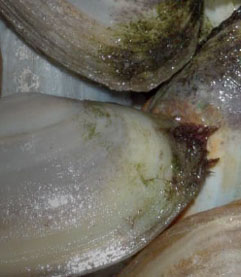 There is no reason for anyone to go hungry in this country, especially if you live by the sea.
There is no reason for anyone to go hungry in this country, especially if you live by the sea.
In most areas of coastline you will find open beaches, sand banks and estuarine flats that, with a little scratching around at the bottom of tide, will turn up shellfish of some description. Shellfish were standard fare for Maori all over New Zealand; middens (rubbish pits) discovered well inland by archaeologists turned up shells that indicate a lively shellfish trade between coastal and inland groups.
{readmore}
Scallops with Dipping Sauce Recipe
SpotX Wild Foods Recipe from Margret Jamieson
Prep:30 minutes Cook:45 minutes Difficulty:1
Ingrediants:
|
Scallops
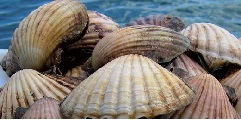 If there is one shellfish that has almost universal appeal it is scallops.
If there is one shellfish that has almost universal appeal it is scallops.
Scallop meat’s delicate but distinct taste lends it to a variety of dishes, and they are available throughout New Zealand from Stewart Island to North Cape.
Scallops are not hard to find. The season is August to February in most areas; although, this does vary from region to region so check with your local Ministry of Fisheries office (0800 4 RULES).
Scallops can be gathered from the shoreline in some harbours and after a decent blow they are occasionally found pushed up onto open-coast beaches. Individual catch limits vary from 20 to 50 according to the region they are gathered in, but universally they must measure 100mm across the shell. Anyone gathering scallops washed up on the shore must also adhere to daily bag limits.
